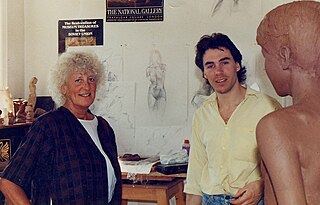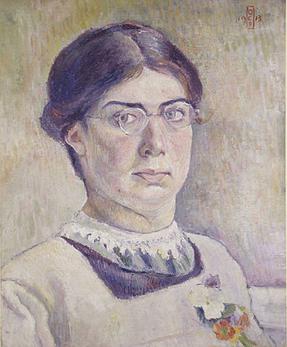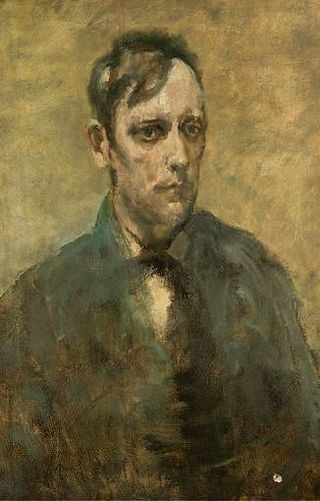Related Research Articles

Post-Impressionism was a predominantly French art movement that developed roughly between 1886 and 1905, from the last Impressionist exhibition to the birth of Fauvism. Post-Impressionism emerged as a reaction against Impressionists' concern for the naturalistic depiction of light and colour. Its broad emphasis on abstract qualities or symbolic content means Post-Impressionism encompasses Les Nabis, Neo-Impressionism, Symbolism, Cloisonnism, the Pont-Aven School, and Synthetism, along with some later Impressionists' work. The movement's principal artists were Paul Cézanne, Paul Gauguin, Vincent van Gogh and Georges Seurat.

Dame Elisabeth Jean Frink was an English sculptor and printmaker. Her Times obituary noted the three essential themes in her work as "the nature of Man; the 'horseness' of horses; and the divine in human form".

Paul Durand-Ruel was a French art dealer associated with the Impressionists and the Barbizon School. Being the first to support artists such as Claude Monet, Camille Pissarro, and Pierre-Auguste Renoir, he is known for his innovations in modernizing art markets, and is generally considered to be the most important art dealer of the 19th century. An ambitious entrepreneur, Durand-Ruel cultivated international interest in French artists by establishing art galleries and exhibitions in London, New York, Berlin, Brussels, among other places. Additionally, he played a role in the decentralization of art markets in France, which prior to the mid-19th century was monopolized by the Salon system.

Dame Ethel Walker was a Scottish painter of portraits, flower-pieces, sea-pieces and decorative compositions. From 1936, Walker was a member of The London Group. Her work displays the influence of Impressionism, Puvis de Chavannes, Gauguin and Asian art. Walker achieved considerable success throughout her career, becoming the first female member elected to the New English Art Club in 1900. Walker's works were exhibited widely during her lifetime, at the Royal Academy, the Royal Society of Arts and at the Lefevre Gallery. She represented Britain at the Venice Biennale four times, in 1922, 1924, 1928 and 1930. Although Walker proclaimed that 'there is no such thing as a woman artist. There are only two kinds of artist — bad and good', she was elected Honorary President of the Women's International Art Club in 1932. Soon after her death, she was the subject of a major retrospective at the Tate in 1951 alongside Gwen John and Frances Hodgkins. Walker is now acknowledged as a lesbian artist, a fact which critics have noted is boldly apparent in her preference for women sitters and female nudes. It has been suggested that Walker was one of the earliest lesbian artists to explore her sexuality openly in her works. While Walker was contemporarily regarded as one of the foremost British women artists, her influence diminished after her death, perhaps due in part to her celebration of female sexuality. Made a Dame Commander of the Order of the British Empire in 1943, Walker was one of only four women artists to receive the honour as of 2010.

Lucien Pissarro was a French landscape painter, printmaker, wood engraver, designer, and printer of fine books. His landscape paintings employ techniques of Impressionism and Neo-Impressionism, but he also exhibited with Les XX. Apart from his landscapes, he painted a few still lifes and family portraits. Until 1890 he worked in France, but thereafter was based in Great Britain. He was the oldest son of the French Impressionist painter Camille Pissarro and his wife Julie.

Orovida Pissarro, known for most of her life as Orovida, was a British painter and etcher. For most of her career she distanced herself from the Impressionist and Post-Impressionist styles of her father, Lucien Pissarro and grandfather, Camille Pissarro, in favour of a technique influenced by Chinese and other Asiatic art; but in the last quarter of her career developed a manner which drew on both traditions.

The Stafford Gallery was an early 20th-century art gallery in London. Artists whose works were exhibited there include both internationally known painters such as Pablo Picasso, Paul Gauguin, Paul Cézanne and Gustave Courbet and significant English figures such as Walter Sickert and Sir William Nicholson.

Arthur Ambrose McEvoy was an English artist. His early works are landscapes and interiors with figures, in a style influenced by James McNeill Whistler. Later he gained success as a portrait painter, mainly of women and often in watercolour.
The International Society of Sculptors, Painters and Gravers was a union of professional artists that existed from 1898 to 1925, "To promote the study, practice, and knowledge of sculpture, painting, etching, lithographing, engraving, and kindred arts in England or elsewhere...". It came to be known simply as The International. The society organised exhibitions, some for members only and some open to others, and social events such as musical evenings and soirées. The exhibitions were held in a number of London venues, and in other cities around England, including Nottingham and Manchester. Its founder and first president was James McNeill Whistler. On his death, the presidency was taken up by Auguste Rodin, with John Lavery as vice-president. The society contributed £500 towards the cost of Whistler's memorial.

The Grafton Galleries, often referred to as the Grafton Gallery, was an art gallery in Mayfair, London. The French art dealer Paul Durand-Ruel showed the first major exhibition in Britain of Impressionist paintings there in 1905. Roger Fry's two famous exhibitions of Post-Impressionist works in 1910 and 1912 were both held at the gallery.
Marjorie Sherlock (1897-1973) was a British painter and etcher. Three books of her etchings were published between 1925 and 1932. Her painting Liverpool Street Station, now in the Government Art Collection, was first shown at the Royal Academy in 1917 and in 1987 was at 10 Downing Street when Margaret Thatcher was Prime Minister of the United Kingdom.

Robert Ernest Clatworthy RA was a British sculptor and teacher of art. He was head of the fine art department at the Central School of Art and Design in London from 1971 to 1975, and was elected a fellow of the Royal Academy of Arts in 1973.
Dora Thacher Clarke, later Dora Middleton, (1895–1989) was a British sculptor and wood carver who also wrote about, and promoted African art.
Carole Steyn is a British abstract and figurative painter, sculptor, pastellist and ceramicist who works with a wide range of materials and lives in London. Steyn's work draws on a range of influences, including her Russian Constructivism-inspired freestanding sculptures; and Bas-Reliefs reminiscent of Nevelson and Camargo.
Lélia Pissarro was born 27 July 1963 in Paris, France and is a contemporary French artist and gallery owner who lives and works in London. She is the great-granddaughter of Camille Pissarro.
Elsie Marian Henderson, later Baroness de Coudenhove, was a British painter and sculptor notable for her animal paintings.
Adolfine Mary Ryland was a British artist who worked as a sculptor, painter and printmaker. Across several different media her work often displayed innovative elements of design and also showed her interest in Indian and Eastern forms of sculpture.

Paul-Émile Pissarro, also Paulémile Pissarro or Paul Émile Pissarro was a French impressionist and neo-impressionist painter. He came from the Pissarro family of artists.
Diana White was a British artist and translator. She painted Impressionist-style landscapes and translated books authored in French and Danish into English. Her most sought-after work is the 1903 book The Descent of Ishtar, of which only 226 copies were printed.

Mary Vermuyden Wheelhouse was a British painter, illustrator, toymaker and suffragette.
References
- ↑ Margaret Geddes (March 1950). The Women's International Art Club. The Studio139 (684): 65–70; cited by Kristen Erickson (1994).
- 1 2 Althea Greenan ([2009]). Women's International Art Club (WIAC). Archives Hub. Accessed September 2013.
- 1 2 3 Julie Tancell (2002). Women's International Art Club. AIM25: Archives in London and the M25 area. Accessed September 2013.
- 1 2 Catherine Speck (2009). Contesting Modernism: Flowers, Portraits, Gum Trees: My Father and Me. Hecate35 (1–2). Accessed September 2013.
- ↑ [s.n.] (1977). The human landscape: catalogue of an exhibition held by the Women's International Art Club at Woodlands Art Gallery, Blackheath, London, 11 June - 12 July 1977. London: W.I.A.C.
- ↑ Kristen Erickson (1994). The Art of Orovida: Looking beyond the Pissarro Family Legacy. Woman's Art Journal15 (2): 14-20. (subscription required)
- ↑ Women's International Art Club. Artist Biographies: British and Irish Artists of the 20th Century. Accessed September 2013.
- ↑ Doreen Costello (1981). List of women artists exhibiting with the Womens International Art Club, 1900–1966. [s.l.]: [s.n.].